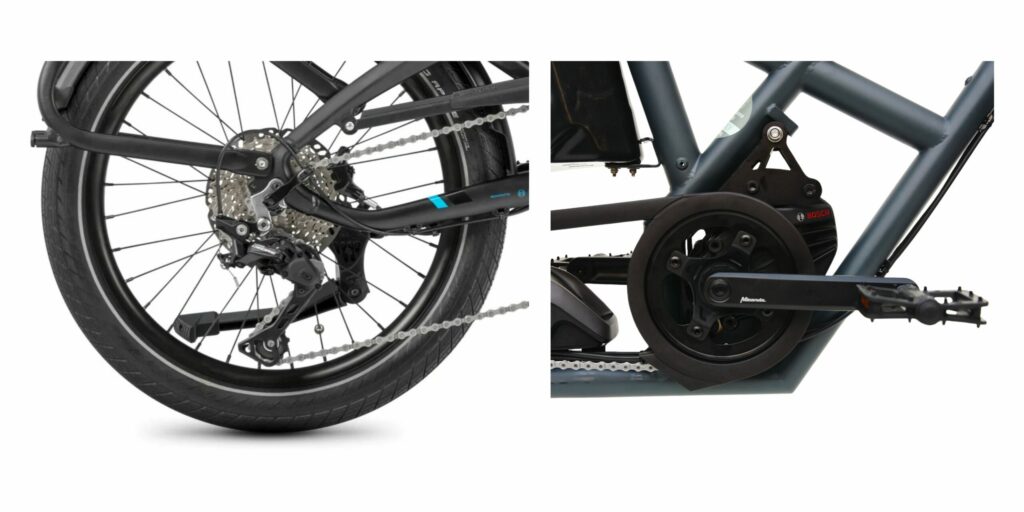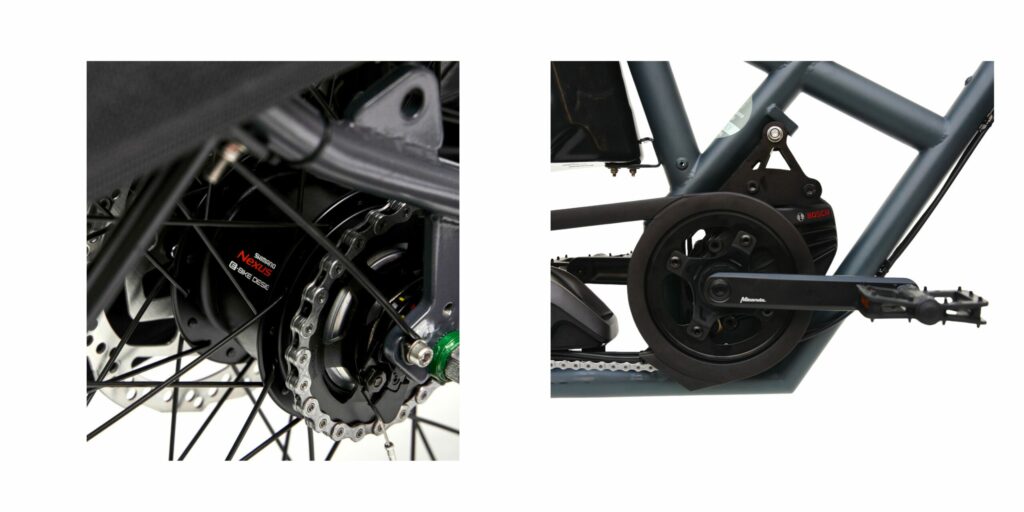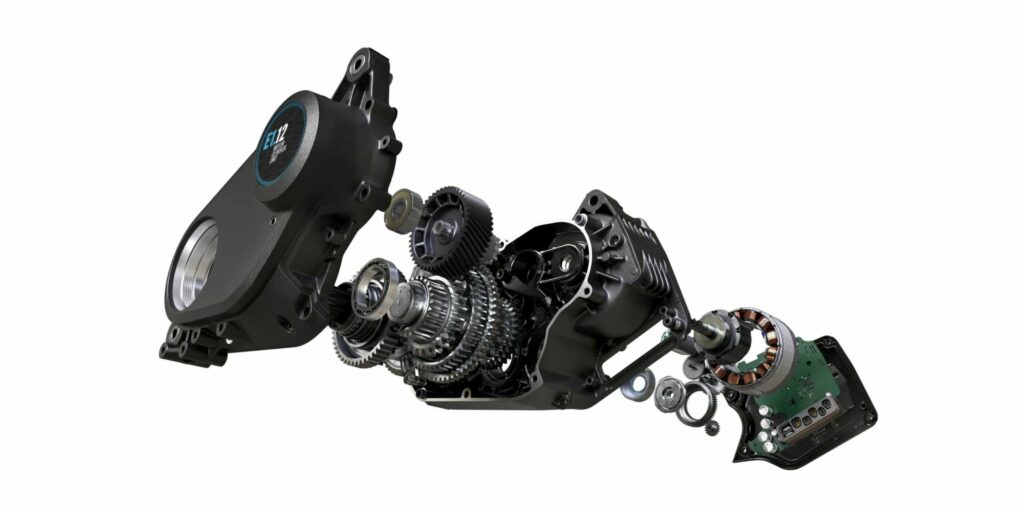Choosing the right motor and transmission for your electric cargo bike is crucial for ensuring that it fits your needs, lifestyle, and the terrain you navigate. With various combinations available, each with its unique strengths and weaknesses, it can be overwhelming to decide. This guide will outline the most common motor and transmission types and provide insights to help you select the best option for your cargo bike.
1. Motor and Transmission Types
Synchronous brushless motors are the most common in modern ebike designs.
In case of a hub motor, the motor is built into the wheel hub itself, while the stator containing the windings is firmly attached to the axle, the magnets are attached to the casing laced to the rim and rotate with it. The hub of a bicycle wheel is a motor. The power levels of the motors depend on the legal categories and are often, but not always, limited to less than 500 watts in peak and 250W continuous (European regulation for an ebike to be considered as a bike according to the traffic law )
The hub motors are either geared (rotating speed reduction between the high speed motor and the low speed wheel), or direct drive (no gear reduction, more magnets, more windings, bigger, heavier and more expensive, but noiseless and wearless).
In case of a mid-motor, also synchronous and brushless, the casing bolted onto the frame holds the windings while the rotating output shaft hosts the magnets.
Depending on the combination motor – transmission, it can be categorized in five types:
Front Wheel Motor
- Advantages: Front wheel motors are typically more affordable and simpler to install. They are often paired with budget-friendly brands like Bafang, making them a good option for riders looking for a cost-effective solution. The torque is usually quite high and low speed power is nice to launch the bike from stand still.
- Disadvantages: The power from a front wheel motor is limited compared to mid-motors. The mid-motors usually deliver more power beyond 20km/h, especially when climbing hills or hauling heavy loads. The distribution of weight can also affect handling, especially on a cargo bike. The troubleshooting of these systems is very challenging because of the many components and cables spread over the bike (battery, controller, motor, torque sensor and connection cables between them).
- Example: Geared : Bafang Front or rear Hub Motor, most lower costs brands, Direct Drive : Neodrive, TDCM, BionX

Central Motor with Derailleur
- Advantages: Central motors, also known as mid-drive motors, are positioned near the bike’s crankset, offering better weight distribution and more importantly they use the bike’s gear system. They can work at their optimum rotating speed whatever is the bike speed. Nowadays they are lighter than hub motors. Additionally, the cooling is better as the windings are thermally connected to the outer casing, which is not the case on hub motors where the windings are on the axle and are not thermally connected with the casing
- Disadvantages: Shifting under load can be problematic, as the chain is under high tension. This type of system also requires frequent chain and cassette maintenance, especially under heavy use.
- Example: Rear Derailleur coupled with Bosch Performance Line, Active LineShimano EP6, Brose Drive3 Peak, Yamaha PW-X3.

Central Motor with Internal Gear Hub (IGH)
- Advantages: IGH systems have several benefits for cargo bike users. With no external derailleur, the chain never shifts, making it less prone to dropping or wear. Gears are sealed within the hub, protecting them from dirt and moisture, which reduces maintenance and increases durability. Additionally, IGH allows you to shift gears while stationary, perfect for stop-and-go traffic. Most IGHs have a number of gears, like 5 or 14, and some others (Enviolo) are stepless.
- Disadvantages: While IGH systems are generally low maintenance, they can be more expensive upfront. However the additional cost is more than compensated after as little as 2000km because of the cost for replacing the cassette and chain on derailleur layouts.
- Example: Bosch Cargoline paired with Enviolo or Bosch Cargoline with Nexus 5, Shimano EP6 with Nexus5 manual.
- Best for: Those looking for a reliable, low-maintenance solution for heavy loads and high mileage.

Central Motor with Internal Automatic Gear Hub
- Advantages: This system automates gear shifting, allowing riders to maintain a steady cadence without manually changing gears. It’s ideal for those who are less familiar with shifting or who want a smoother, more intuitive ride. In some cases the motor controller is also managing the shifting including a power cut during the shifting, in other cases the shifting controller isn’t integrated into the motor controller and works independently.
- Example: Bosch Cargoline with Enviolo Automatic, Shimano EP6 with Nexus5 Di2.
Integrated Gearbox Motor
- Advantages: Integrated gearboxes like Pinion or Owuru are built into the frame, offering exceptional durability and precision. They can handle shifting under load, making them perfect for tackling hills with heavy cargo. Another advantage is to have a single brain managing the motor and the shifting, the shifting controller has access to more sensors and if the software is refined enough the shifting logic is better.
- Disadvantages: These systems are often more expensive and complex. It’s also early ages so that the system are under development.
- Example: Pinion Gearbox System

2. Choosing a Motor Based on Your Needs
Living in hilly terrain or carrying heavy loads: If you frequently ride in hilly areas or carry significant loads, opt for a powerful motor with high torque. Motors with integrated gear systems, like the Bosch Cargoline paired with an internal hub, are perfect for these conditions. Look for a system that offers strong torque (Nm), as this will make climbing hills easier and allow for better performance at lower cadences. Also pay attention to the speed range, for instance the Enviolo hubs have wider gear range compared to Nexus 5.
Not used to cycling or prefer simplicity: For those less familiar with cycling, or who prefer an effortless ride, a central motor with an internal automatic gear hub is a great choice. Systems like the Bosch Cargoline with Enviolo Automatic will choose the gears based on your preferred pedaling speed, ensuring a smooth, stress-free ride without the need to manually shift gears.
Pedal preference – High or low cadence: Your pedaling style also influences the type of motor you should choose. For example, Yamaha motors perform better at low cadence, providing powerful torque for slower, steadier pedaling. Bosch motors, on the other hand, are known for delivering better performance at both low and high cadences, making them versatile for riders who vary their pedaling speed. If you prefer a faster pedaling cadence, Shimano E6100 might be a better fit for lighter cargo loads.
3. Conclusion
Selecting the right motor and transmission for your cargo bike depends on several factors: terrain, load capacity, pedaling style, and personal preferences. If you’re riding in hilly areas with a heavy load, go for a powerful motor with an integrated transmission. For everyday use with minimal maintenance, a central motor with an internal gear hub is ideal. And for those new to cycling, an automatic gear hub or integrated gearbox motor will offer a hassle-free experience.
Remember, it’s not just about power—finding the perfect fit for your riding style and the bike’s intended use will provide a more enjoyable and efficient experience.

